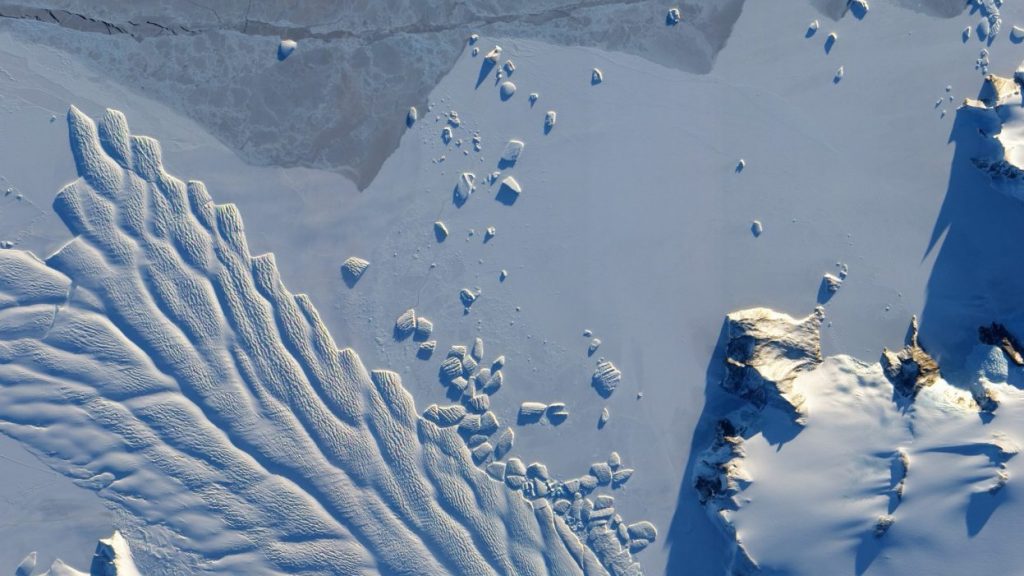
New fast ice database delivers a data boost to climate simulations
A multi-agency team of researchers has completed an important piece of the Antarctic climate jigsaw puzzle, with the creation of the first detailed database of changes in land-fast sea ice.
Land-fast ice is more commonly known as ‘fast ice’, and it describes sea ice that is fastened to the shore or the sea floor around Antarctica, and does not move with the pack ice.
Fast ice is an important feature of the Antarctic coastline for a range of reasons, including that it provides foraging and breeding habitat for Emperor penguins.
Many Antarctic stations are situated within bays that seasonally-covered by fast ice, so any changes in its coverage can affect polar navigation and base resupply.
It also plays a crucially important role in the global climate system, because it is associated with the formation of large areas of ice-free ocean called ‘polynyas’, where freezing Antarctic winds drive about 15% of the formation of fresh sea ice.
Dr Alex Fraser, a remote sensing specialist formerly with the Antarctic Gateway Partnership and now with the AAPP, says work on the database took about six years, and involved a multi-national team from Australia, Japan, England, Germany and the United States.
“The completion of this database is an important milestone for understanding Antarctica’s role in the climate and ecological systems,” Dr Fraser said.
“This data is a key missing piece of the Antarctic sea ice puzzle that is not currently represented in climate simulations, so it is a valuable data product for climate modellers.”
“This work addresses a key knowledge gap identified by the Intergovernmental Panel on Climate Change, which is why we are so pleased to release it to the global research community.”
“The next stage for us is to begin analysing the data to determine where fast ice is increasing or decreasing around Antarctica, and what ocean or atmospheric factors are driving these changes.”
“It’s very important that scientists are able to incorporate realistic fast ice into the next generation of climate models, because this will help address a whole range of climate-related questions.”
The research is published in the journal Earth System Science Data.
WHY IS FAST ICE IMPORTANT?
Ice shelves and floating glacier tongues surrounded and buffered by fast ice tend to be more resilient against breakup and disintegration from the energy of ocean waves.
Fast ice is known to enlarge coastal polynyas, which are regions where dense Antarctic Bottom Water is formed. AABW is the densest class of water in the ocean, and drives the global ocean circulation by sinking to the bottom of the ocean.
Recent work has shown that the accurate representation of fast ice in ocean models produces more accurate estimation of glacier melt
Emperor penguins use fast ice as a breeding platform, and hence may be sensitive to trends in fast ice extent.
This research was supported by the former Antarctic Gateway Partnership (AGP), an Australian Research Council Special Research Initiative, and the Antarctic Climate & Ecosystems Cooperative Research Centre (ACE CRC) funded by the Department of Industry, Science, Energy and Resources (DISER).
It also included contributions by the Australian Antarctic Program Partnership (AAPP). The AAPP is funded by the Australian Government Department of Industry, Science, Energy and Resources through the Antarctic Science Collaboration Initiative. The core partners of the AAPP are the Australian Antarctic Division (AAD), CSIRO, the University of Tasmania, and the Bureau of Meteorology (BoM). Other partners include Geoscience Australia (GA), the Tasmanian State Government and Australia’s Integrated Marine Observing System (IMOS). \
Media Contact:
David Reilly
Phone: 0428 510 641
Email: David.Reilly@mediaswitch.com.au



